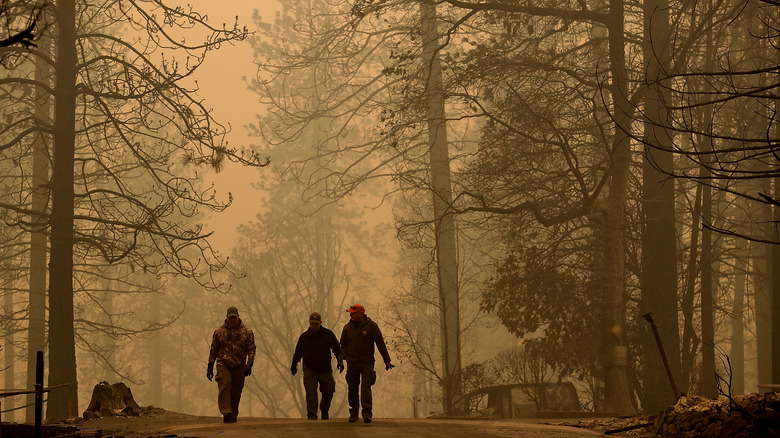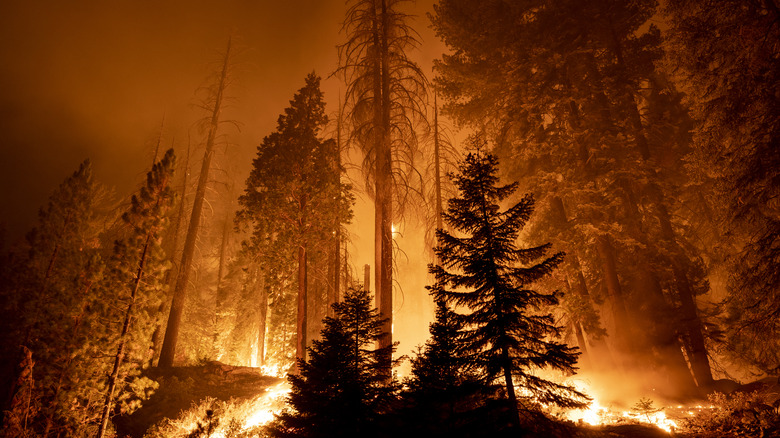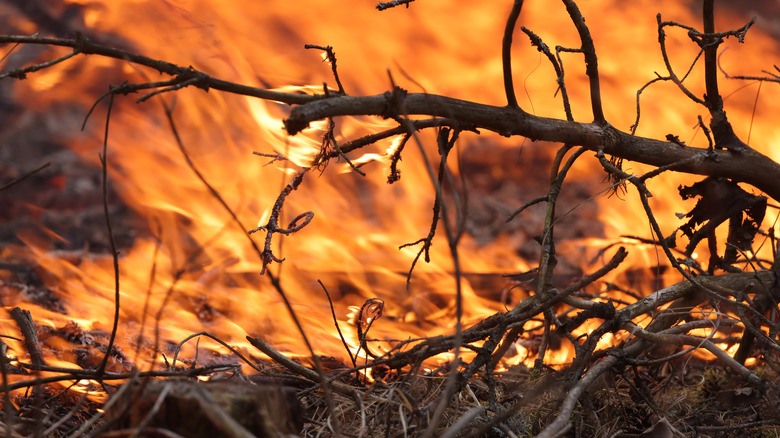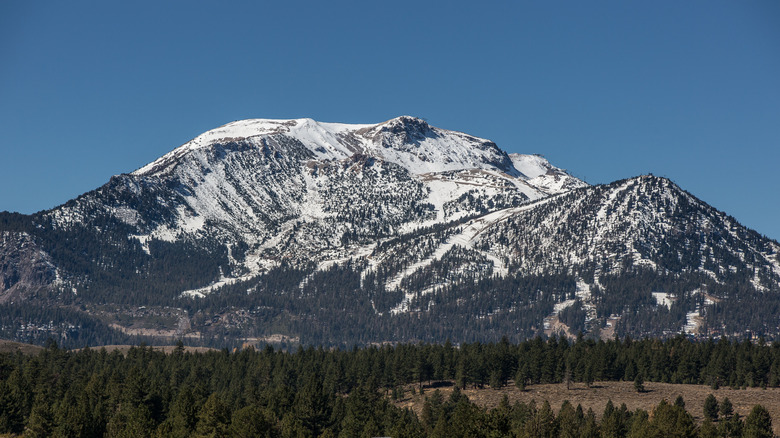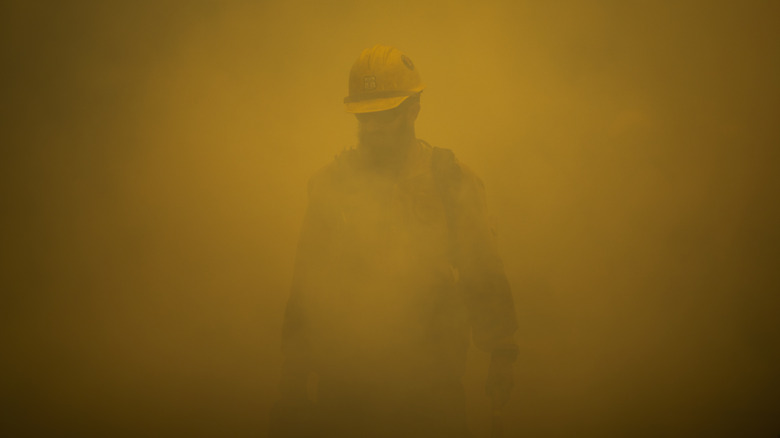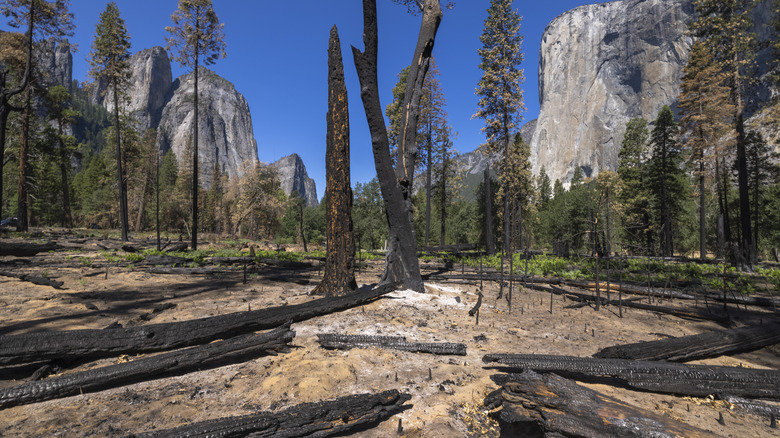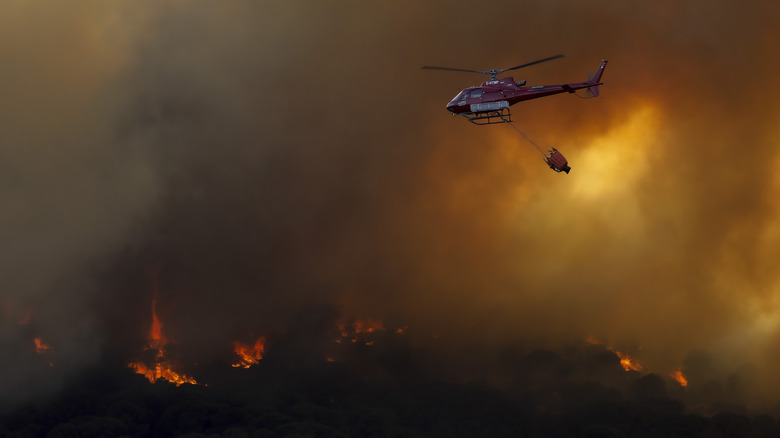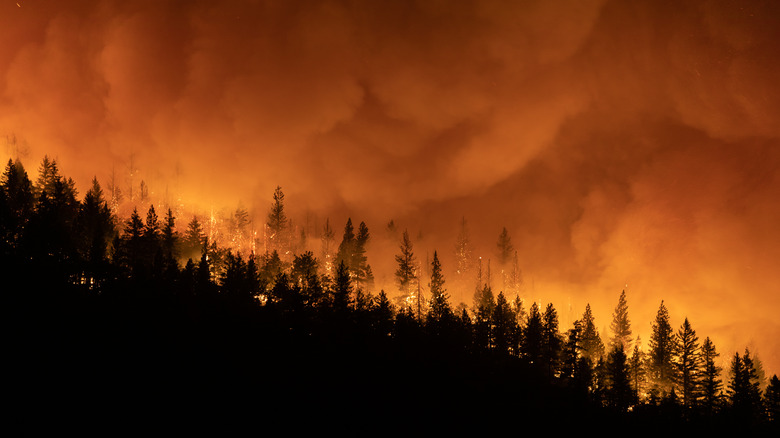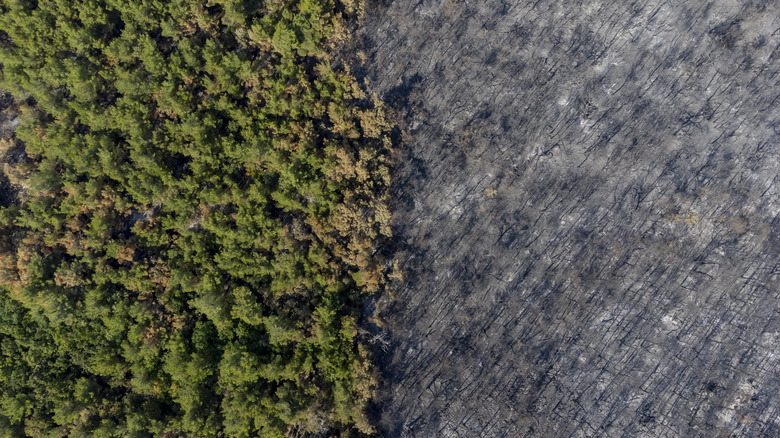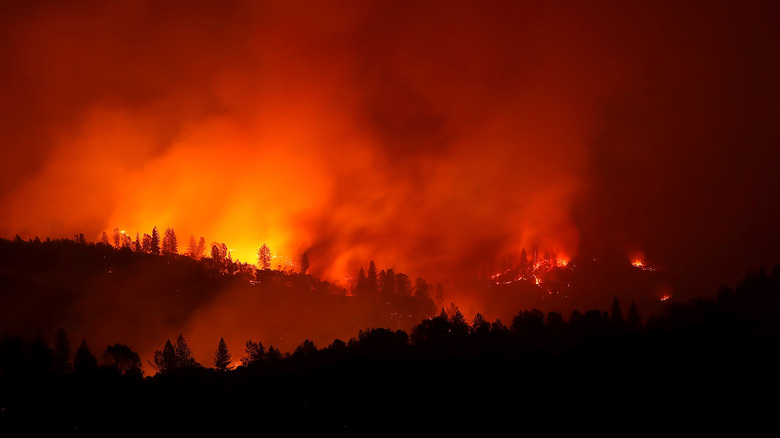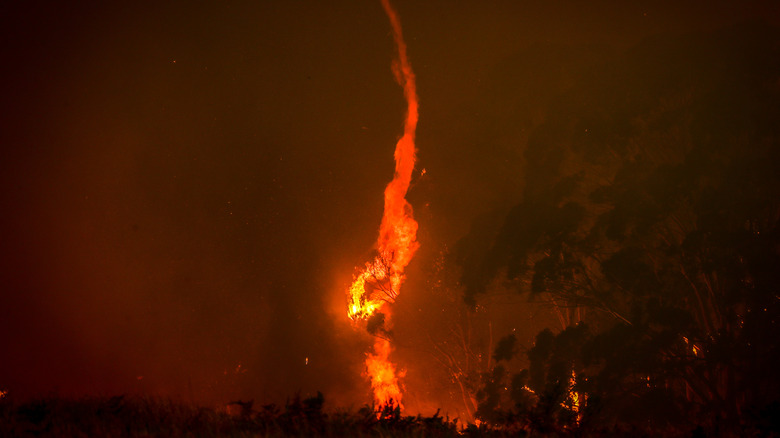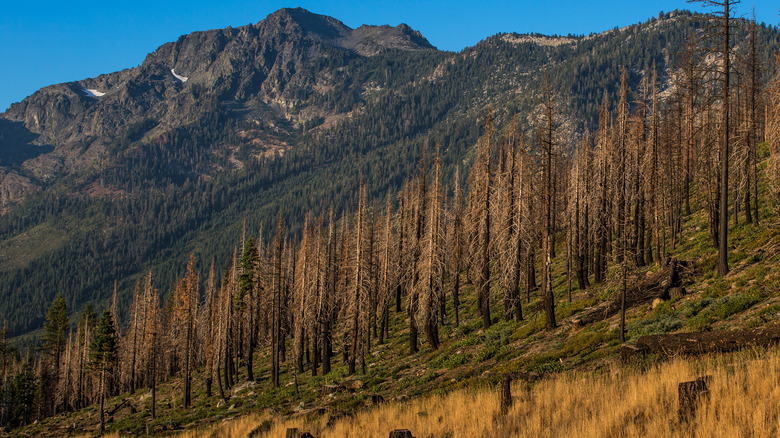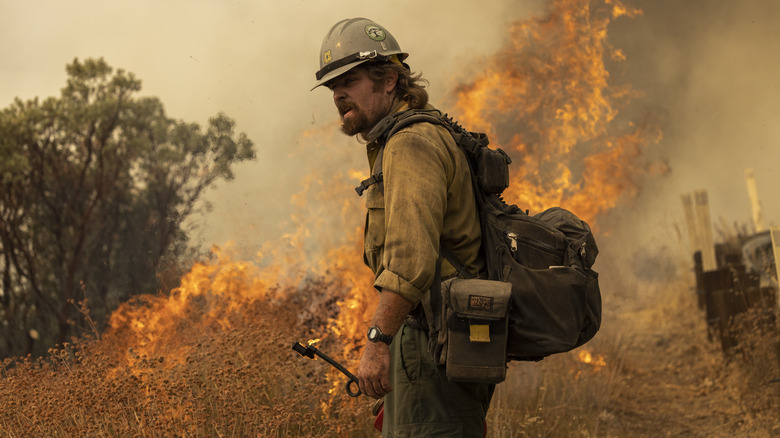12 Ways Climate Change Impacts Wildfires
Nature is equal parts beautiful and terrifying, with some super disturbing moments thrown in for good measure. Wildfires are definitely all three: They are, after all, vast acres of fire spreading at terrifying speeds, consuming everything in their path. In recent years, that's started to include more and more homes, buildings, and towns — and according to the World Meteorological Organization, it's only going to get worse. It's pretty dire stuff: Estimates suggest that by 2030, instances of so-called "extreme fires" are going to rise by 14%. Make that 30% by 2050, and by 2100? 50%.
Right, so what do those percentages mean? In 2021, the National Interagency Fire Center reported (via Disaster Philanthropy) that over the course of the entire year, 58,733 wildfires had consumed more than 7.13 million acres. So, that's not great — and that's just in the U.S. The Guardian reported that in July of 2022, 1.27 million acres had been consumed by wildfires in outbreaks across Europe. Those were linked to extreme temperatures and heat waves, and that's going to be happening more and more often.
As if the idea of more wildfires isn't terrifying enough, climate scientists suggest that the damage done to the environment, rising temperatures, funky weather patterns, and shifting seasons isn't just going to make fires more frequent, but it's going to change how they burn and what they look like, too. The news? It isn't good.
Drought conditions increase the risk fires will start
The connection between droughts and climate change is a complicated one, but according to Yale Climate Connections, the data is pretty clear: Temperatures are rising, and droughts are becoming more frequent and more severe. What that means for wildfires is actually kind of surprising. Terrible, but surprising.
The North Carolina Climate Office took an in-depth look at the relationship between the two and found that there's no one-size-fits-all scenario. On the surface, it's pretty straightforward: Everything gets drier, vegetation ignites easier, and fires spread faster and farther.
But not all droughts are created equal, and for the best example, let's look to the seasons. Some weather patterns — like La Niña — result in relatively dry, warm winters. Without months of cooler temperatures, snow, and rain, the land is going to get drier in the summer and lead to the potential for more wildfires. But now, there's another phenomenon going on, too. When weather patterns — like those influenced by El Niño — lead to wet winters, that's turning into a problem, too. Wet winters and spring months with higher rainfall lead to the growth of grasses and underbrush, but once the summer droughts kick in, that means there's much more vegetation to dry out and ultimately fuel fires. The result is potentially even bigger fires.
A drier landscape means more fuel ... to a point
Fires need fuel to burn, and the more fuel they have, the bigger and hotter they'll be ... right? Yes, but start looking at fuel and wildfires through the lens of climate change, and here's what NASA says happens when there's not just a drought, but a megadrought.
First, what's a megadrought? That, says the Smithsonian, is a period of severe drought that lasts for more than 20 years — and climate scientists think that we might be headed into one. They've happened before — it's believed that one was responsible for the mass abandonment of the Anasazi cliff dwellings — and they're the sort of thing that devastates the environment and the people who live in it. The last megadrought was in the late 1500s, and some current climate models suggest that the probability of having a megadrought before the year 2100 is around 90%. What would that mean for wildfires? Here's where the fuel comes in.
There's at least a little bit of good news in terms of wildfires, and that's the fact that a megadrought could put an end to them. Ben Cook of the Goddard Institute for Space Studies says that if megadroughts last for decades, then all the trees and vegetation that normally fuels wildfires will just be gone. With nothing to burn, there won't be wildfires, but ... there won't be anything else, either — so it's not really a trade-off we should want to make.
Winter snowpacks are melting earlier
In 2019, researchers from Portland State University published the findings of a climate study in the journal Nature Communications (via Science Daily). They found that the extreme wildfires that were happening across the western U.S. were actually causing the winter snows to melt earlier than normal, and here's the shocking thing: After an area was devastated by fire, snows not only melted an average of five days earlier, but the impacts were seen for as long as 15 years after the fire. Sounds impossible, right? It's not: Researchers say that it happens because the destruction of forests and the creation of black soot and ash increases the snow's exposure to sunlight.
And that's just half the story. They also say that these early snows are shaping future wildfires, too: Kelly Gleason of the Desert Research Institute explains, "Snow is already melting earlier because of climate change. When it melts earlier, it's causing larger and longer-lasting fires on the landscape. Those fires then have a feedback into the snow itself, driving an even earlier snowmelt, which then causes more fires. It's a vicious cycle."
There's one more component to this, too. National Geographic says that courtesy of climate change, snows are also forming later. That's giving vegetation more time to dry, which is leading to longer wildfire seasons and more fires.
The complicated relationship between humidity and fires
When it comes right down to it, fire is pretty easy to make. Weather, however, is extremely complicated, and there are tons of variables that impact things like wildfires — including humidity. National Geographic took a look at the relationship between temperatures and humidity and explained how they acted together to influence wildfires.
First, let's put this in perspective by saying that globally, the average temperature has risen about 1.8 degrees Fahrenheit since the Industrial Revolution of the 1800s. (In some areas — like California — the average has risen nearly twice that.) That's influencing something called the vapor pressure deficit, which is basically a measure described as "the difference between how much water the air holds and how much it could hold."
And here's the problem: Not only does hot air absorb moisture from everything from lakes and rivers to vegetation, but the hotter it is, the more water it can hold. It's not an even scale, either — the hotter air gets, the amount of water it can hold increases exponentially. In other words, small temperature changes mean massive increases in what the air can absorb for the environment. When it stays like that for too long, it can have a measurable impact on how dry vegetation gets. And that? That means more kindling for wildfires.
Natural firebreaks aren't working any more
In 2021, the news media was reporting on wildfires that were sweeping across California. They were consuming tens of thousands of acres, but according to the Los Angeles Times, that's not all they were doing — they were also spreading into places that had previously been considered safe.
Chief Thom Porter of the California Department of Forestry and Fire Protection said that both the Dixie Fire and the Caldor Fire had done something unprecedented: They'd burned their way from one side of the Sierra Mountains to the other. "Two times in our history, and they're both happening this month," he said of the phenomenon. "There is fire activity happening in California that we have never seen before." Spokespeople from Cal Fire explained that wildfires' ability to spread past formations that had previously acted as firebreak was a result of "drought, changing climate, and un-resilient forest stands." The Sierras weren't the only place they saw it happening, either.
Overlooking the Tahoe basin is a granite ridge that has always acted as a barrier to slow the spread of wildfires. In addition to wide granite expanses, it's covered with relatively slow-burning fir trees and open spaces. Now, however, winds have been seen carrying embers well past the one-time barrier and spreading it toward Tahoe communities — many of which are made up of log cabins. UC Merced fire scientist Crystal Kolden warned: "That basically is no longer a viable last line of defense."
Water shortages make it harder to keep fires under control
Here's another way climate change is impacting wildfires in a bizarrely unpredictable sort of domino effect. According to Forbes, snow is one of the most useful tools when it comes to predicting both weather patterns and how healthy water resources are. With climate change interfering with snows and melting, that's left scientists scrambling to try to figure out exactly what's happening out there. One thing that they're seeing already are water shortages, and according to what Carroll Wills of the California Professional Firefighters Association told LiveScience, it's allowing wildfires to spread farther as firefighters have to look harder to find enough water to put them out.
One of the major ways firefighters fight wildfires is from the air: Helicopters armed with massive water tanks fill up in lakes, reservoirs, and other waterways, then dump the water onto the fire. "Aerial firefighters just have to go farther to find bodies of water," Wills explained. "It makes the job more difficult, because water is what puts fires out."
While climate change-induced water shortages are giving wildfires the chance to burn longer, those same fires are feeding the whole unstable system. According to research from UCLA (via the Los Angeles Times), fires have led to reduced underbrush — so when the rains do come, there's not as much holding everything in place. Mudslides and catastrophic erosion are going to be more common, along with reduced water quality and shifting water runoff patterns.
Increased wind speed spreads fires faster and farther
Wildfires are happening all over the country, not just in the west. According to The Maine Monitor, Maine saw 1,157 wildfires in 2020, and forest ranger Joe Mints said they had a major concern: wind speeds. Anything over 10 mph is considered problematic, and historically, some of the most destructive wildfires have been spread by sustained winds. And guess what? Is climate change increasing wind speeds? Of course it is!
While wind data hasn't been studied as extensively as other components of climate change, scientists do know a bit about what's going on. In 2019, Scientific American reported on a study that suggested wind speeds had increased around 6% since 2010. That's not much of a data set, but in 2021, the Columbia Climate School reported on a fascinating study that had allowed for the development of a method of studying ancient wind patterns by analyzing the dust in samples of deep sea sediment. That allowed them to go back 5 million years to look at what happened then, compare it to what's happening now, and confirm that the winds are, indeed, a'changin'.
What does that mean for wildfires? According to research published via ScienceDirect, the general rule "equates the forward rate of fire spread to 10% of the average open wind speed." In other words? Faster winds, faster fire.
Fires are burning hotter and hotter
First, here's a little tidbit of information to keep in mind: According to the City of Phoenix, exposure to water that's 156 degrees Fahrenheit for just one second is enough to cause third-degree burns. Now, let's talk about wildfires. In 2022, Europe saw the worst wildfire season it had experienced since 2017 — and according to Reuters, they made that determination in July. (Pictured is a forest in Greece, devastated by fire.) Researchers from Copernicus — the EU's Earth observation program — said that it wasn't just a matter of more or bigger fires, but more intense fires. They were burning hotter, and it's worth mentioning just how hot that is.
In 2019, Scientific American set up a camera in the middle of a controlled-burn wildfire to capture some truly terrifying images. That fire was pretty average, hitting somewhere around 1,472 degrees Fahrenheit. Because that's just a big number, let's put it in perspective: That's hot enough to easily cremate a person.
In 2021, the USDA teamed up with a multi-agency group to study not just fires, but the immediate and lasting impacts it had on the environment. They found temperatures of up to 2,000 degrees Fahrenheit, and for another comparison, Caltech says that the average surface of the sun is about five times that.
Fires will be getting taller and taller
Photos and video from 2021's Camp Fire wildfires look like something out of a sci-fi movie, horror movie, disaster flick, or some hellish combination of the three. According to what University of Utah atmospheric scientist Adam Kochanski has said (via NASA), those kinds of fires are going to be the norm rather than the exception.
Flames reached up into the treetops, turning the skies yellow, orange, and red — those skies themselves looked like they were on fire, and here's what's happening. Wildfires that burn through areas where the underbrush is damp and the vegetation has retained moisture tend to burn low to the ground. Fuel there will burn out before the trees catch, but that's not likely to be the case for long.
"Once we change the climatology and get drier and drier fuels, we should expect more intense fires and higher fire severity," he explained. Once rising temperatures and drought conditions get to the point where trees turn into very tall kindling, wildfires will be more frequently spreading into the canopy. As the U.S. learned from the Camp Fire, that means fires are going to be harder to put out, harder to control, and do much, much more damage.
Firestorms and fire tornadoes will be more common
Quick, what's more terrifying than a tornado? How about a tornado made from fire? Is that even a thing? Absolutely, and it's going to happen a lot more in the future, because this is the fresh hell the world exists in now.
According to National Geographic, the large-scale wildfires that are going to become more and more common with the strengthening effects of climate change are so huge and so powerful that they're capable of generating their own weather systems — and perhaps predictably, it's the kind of weather system that might seem perfectly suited to being a backdrop for Dante's "Inferno." They include things like pyrocumulonimbus clouds, and those are best summed up by NASA's description: "fire-breathing dragon ... clouds." So, that's fun.
These clouds — and the firestorms they spawn — can reach heights of up to six miles. They spew lightning (and almost never rain), and when the winds kick up, these fire-and-lightning clouds can twist into fire tornadoes. They tend to be relatively low to the ground and just as short-lived, but given that they can reach top speeds of 140 mph, they can wipe out anything in their path. In 2018, a fire tornado killed four people during the Carr fire, and yes, a single wildfire can spawn multiple tornadoes.
Climate change, tree death, and a vicious cycle
Walking through an old-growth forest is incredible: There's something just cool about being surrounded by trees that were alive when Alexander the Great was just a kid — and anyone who can't appreciate that should probably check to see if they still have a soul.
Unfortunately, climate change is ruining forests, too: According to National Geographic, the years since about 2014 have seen the mass die-off of millions of trees, particularly through the Sierra Nevada (pictured). At the highest elevations, around 80% of trees died over a period of just a few years, and actual numbers topped 150 million dead trees.
Or, in other words, 150 million pieces of kindling. The drought that killed the trees in the first place continued to dry them out, and perhaps predictably, wildfires happened — but that's not the end of the story. Researchers from The University of Utah found that all these dead trees were adding a whole new layer to the destructive nature of wildfires: The fires were also releasing tons of carbon dioxide back into the atmosphere. And that's one of the greenhouse gases that's causing a lot of the problems in the first place, and here's where it turns into a really stupid carnival carousel. The Smithsonian says that new growth forests don't have the carbon storage capacity that old growth forests do, so just as climate change is making wildfires worse, wildfires are making climate change worse. 'Round and 'round we go!
There's no such thing as fire season anymore
Way back in the good ol' days, wildfire season was the four months that covered late summer into the beginning of autumn. Thanks to climate change, that's not the case anymore: According to the U.S. Forest Service (via The Guardian), wildfire season is now about eight months long. Is it going to get worse? Probably! Because that's just what's happening with the world these days.
California was, once again, overwhelmed with wildfires in 2022, and it led Chief Brian Fennessy of the Orange County Fire Authority to warn the public (via ABC), "We no longer have a fire season — we have a fire year." Rising temperatures meant that while winters used to be the quiet time, that wasn't the case anymore — and it's looking more and more likely that's going to be the case in areas outside of California, too. Wildfires described as megafires — those that destroy more than 100,000 acres — have gone from "Nearly non-existent," to "Get ready, it's another one."
As if that isn't terrifying enough, U.S. Forest Service research ecologist Eric Knapp summed it up like this: "We have crossed some thresholds where fire is increasingly hard to control. It is kind of controlling us at this point."
